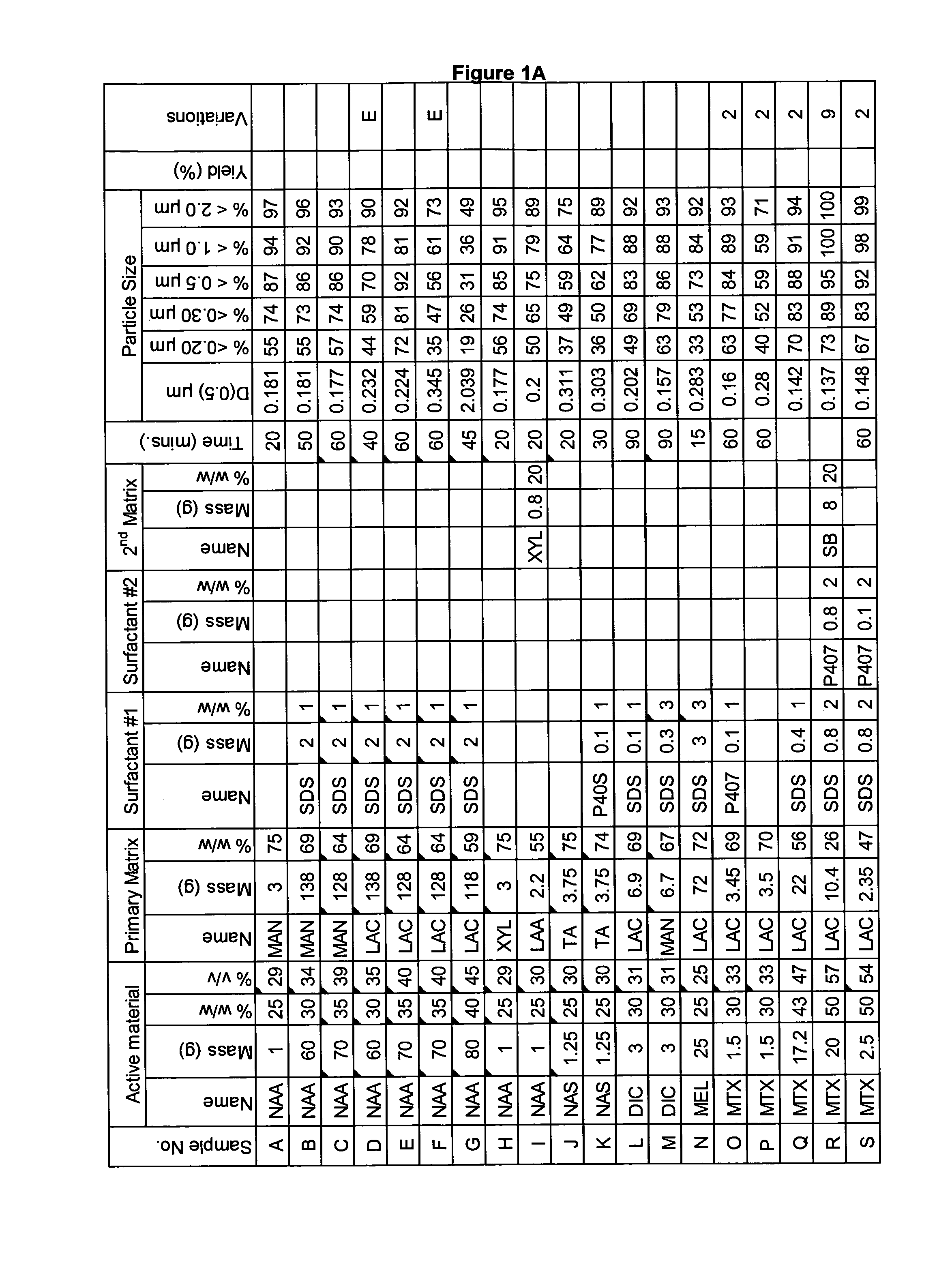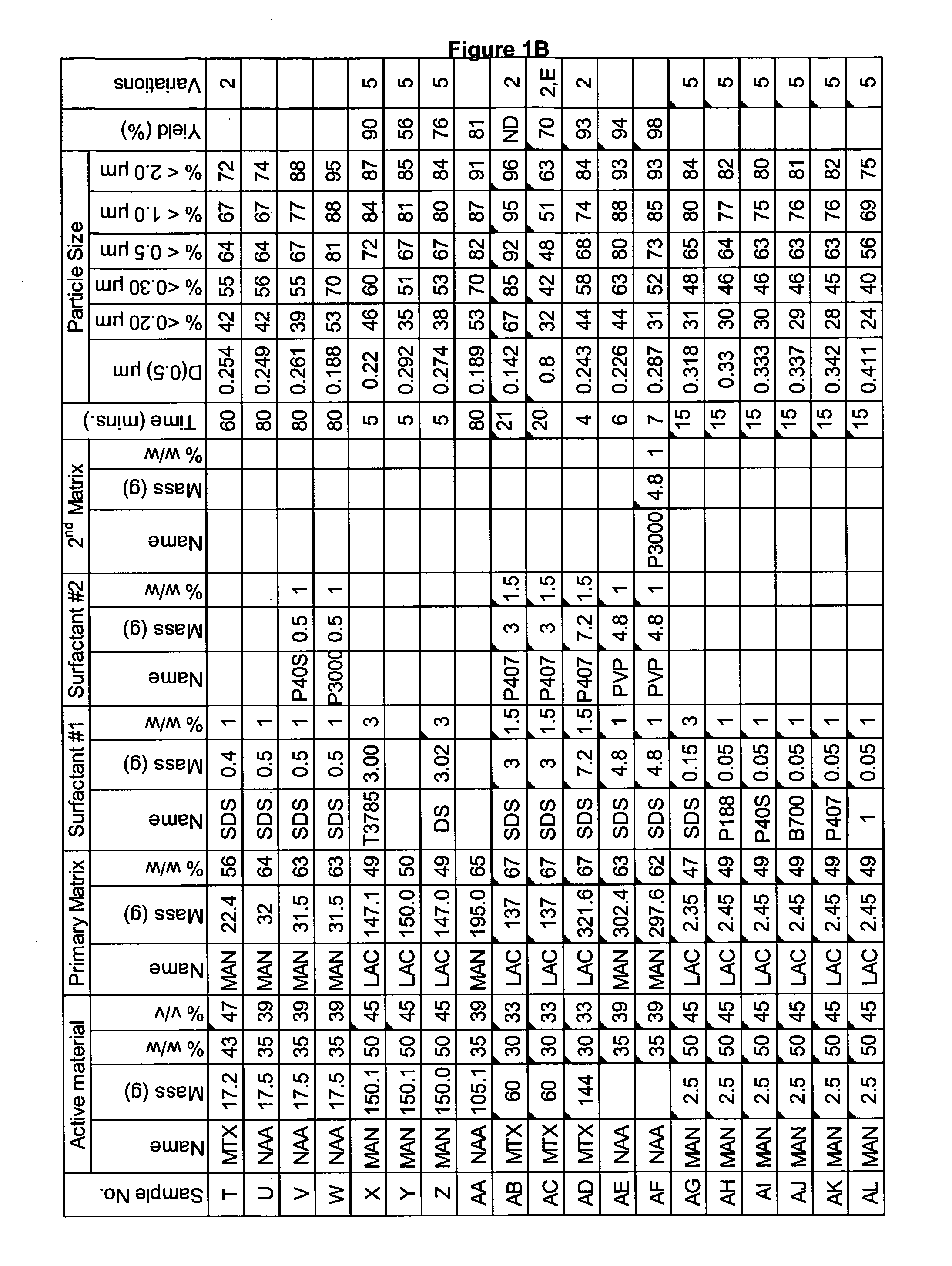Production of encapsulated nanoparticles at high volume fractions
a technology of nanoparticles and nanoparticles, which is applied in the direction of granulation using vibration, drug compositions, grain treatments, etc., can solve the problems of poor bioavailability, unsafe intravenous administration of poorly soluble active agents, and poor bioavailability
- Summary
- Abstract
- Description
- Claims
- Application Information
AI Technical Summary
Benefits of technology
Problems solved by technology
Method used
Image
Examples
example 1
High Volume Fraction Milling
[0282]A range of actives, matrices and surfactants in a variety of combinations were milled using a variety of mills. The details of these millings are shown in FIG. 1A-C together with the particle size distributions of actives that were milled.
[0283]FIG. 1A-C shows that a variety of actives can be milled at high volume fraction (v / v %≧25%) with the invention described herein and produce nanoparticles. Milling at high volume fraction can be achieved in a variety of mills as demonstrated by Samples A, H-L, O, P, S, AG-AQ, milled in SPEX mill; Samples B, D, X-AC, milled in ½ gallon 1S attritor mill; Samples C, E, G, milled in Simoloyer horizontal attritor mill; Sample M, milled in 110 mL HD01 attritor mill; Sample N, milled in 1 L HD01 attritor mill; Samples Q, R, T-W, milled in 750 ml 1S attritor mill and Samples AD-AF, milled in HICOM mill.
example 2
[0284]Naproxen was milled in mannitol with a range of surfactants using the ½ Gallon 1S mill. The details of these millings are shown in FIG. 2A together with the particle size distributions of actives that were milled.
[0285]Naproxen acid milled in Mannitol with a surfactant (Sample A, D-J in FIG. 2A) leads to higher yields, as compared to Naproxen acid milled in Mannitol without surfactant (Sample K, FIG. 2A). Naproxen acid milled in Mannitol and either microcrystalline cellulose or the disintegrant primellose (sample L or M, FIG. 2A) leads to small particle size with D(0.5) around 0.25 in both cases.
example 3
[0286]Some matrices, milling aids or facilitating agents that are used by this invention are not water soluble. Examples of these are microcrystalline cellulose and disintegrants such as croscarmellose and sodium starch glycolate. In order to more easily characterise the particle size of the active after milling with these materials filtration methods can be used to remove them allowing a characterisation of the active. In the following examples naproxen was milled with lactose monohydrate and microcrystalline cellulose (MCC). The particle size was characterised before and after filtration and the ability of the filters to let through the naproxen was demonstrated using HPLC assays. The milling details and the particle size are shown in FIG. 3a. Note in this table the particle size with milling details is un-filtered. The particle size in the rows with no milling details is after filtration. The sample that was filtered is indicated in the Active material section. The HPLC...
PUM
| Property | Measurement | Unit |
|---|---|---|
| particle size | aaaaa | aaaaa |
| particle size | aaaaa | aaaaa |
| particle size | aaaaa | aaaaa |
Abstract
Description
Claims
Application Information
 Login to View More
Login to View More - R&D
- Intellectual Property
- Life Sciences
- Materials
- Tech Scout
- Unparalleled Data Quality
- Higher Quality Content
- 60% Fewer Hallucinations
Browse by: Latest US Patents, China's latest patents, Technical Efficacy Thesaurus, Application Domain, Technology Topic, Popular Technical Reports.
© 2025 PatSnap. All rights reserved.Legal|Privacy policy|Modern Slavery Act Transparency Statement|Sitemap|About US| Contact US: help@patsnap.com



